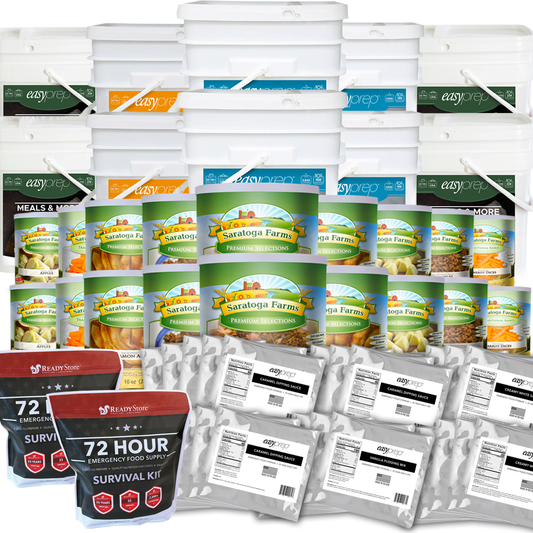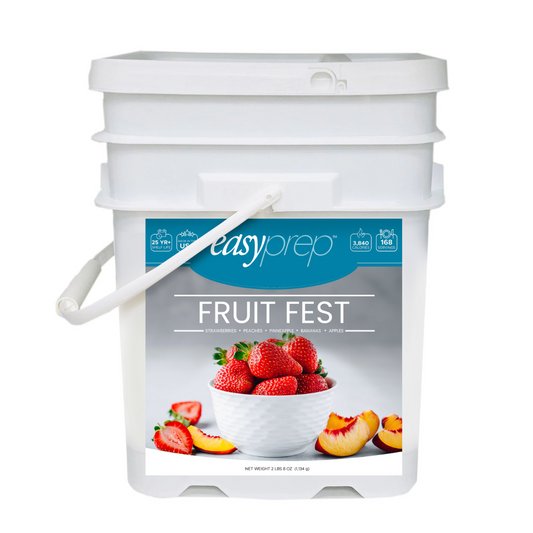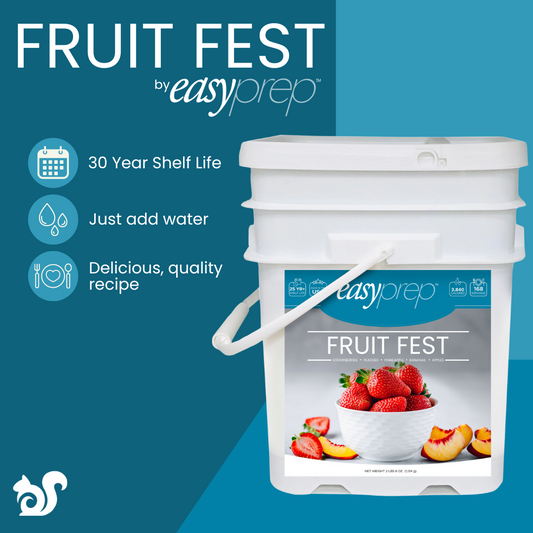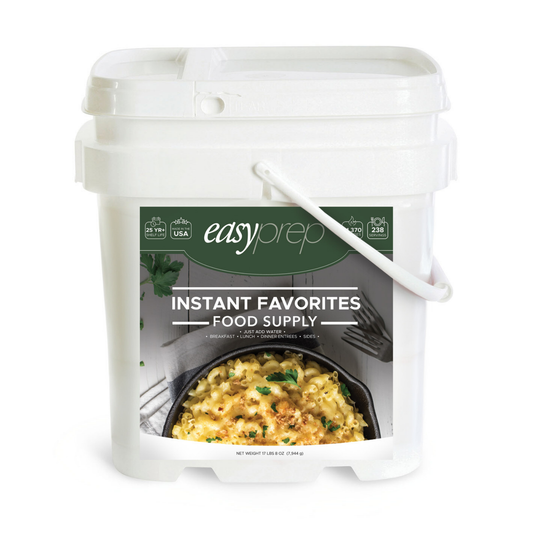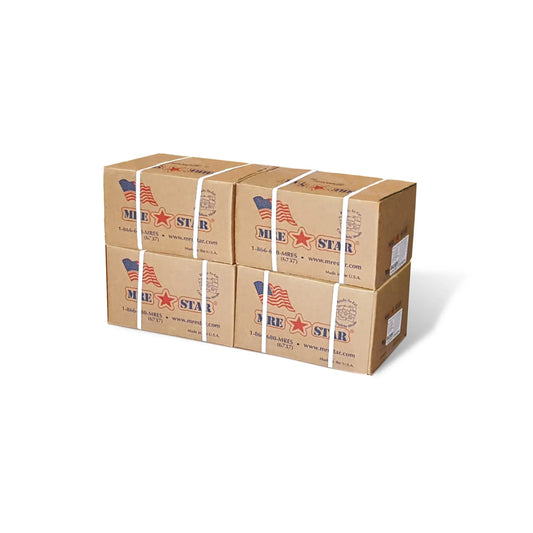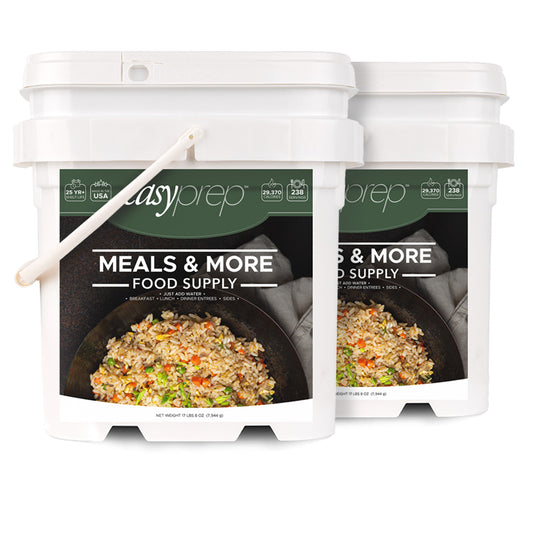DIY Well Digging- How to Drive Your Own Well
25 Jan 2017
In the event of an emergency, one of the most important things you'll need is a good source of water. You can't always trust municipal water facilities to export clean, uncontaminated water. To take control of your water, an easy solution is to dig your own well. While there are different options when it comes to digging wells, the easiest and fastest way (as well as the most cost effective) is to drive a well.
To drive a well, you need some basic materials:
- A wellpoint or drive point. (A pipe with a sharp, solid end and openings throughout the pipe  large enough to let water in, yet small enough to prevent course particles from entering.)
- Riser pipes in 5-6 feet lengths.
- Pipe couplings to attach wellpoint and riser pipes.
- Drive cap to put on the riser pipe while pounding
- Thread compound to seal joints
- Post hole digger/ auger
- Sledge hammer or post driver
- 2 pipe wrenches
1- Determine the correct site for your water. You may need a permit to dig. Well driving is best for areas that do not have clay or rock rich soil. Also, it is recommended that the water table is within 25 feet of the surface. (Ideas for finding the right water source are at the end of this article.)
2- Choose the right wellpoint for your area. Talk to your local hardware dealer to determine the
large enough to let water in, yet small enough to prevent course particles from entering.)
- Riser pipes in 5-6 feet lengths.
- Pipe couplings to attach wellpoint and riser pipes.
- Drive cap to put on the riser pipe while pounding
- Thread compound to seal joints
- Post hole digger/ auger
- Sledge hammer or post driver
- 2 pipe wrenches
1- Determine the correct site for your water. You may need a permit to dig. Well driving is best for areas that do not have clay or rock rich soil. Also, it is recommended that the water table is within 25 feet of the surface. (Ideas for finding the right water source are at the end of this article.)
2- Choose the right wellpoint for your area. Talk to your local hardware dealer to determine the  correct type you will need. Note that stainless wellpoints last longer and resist mineral incrustation.
3- Dig a 2-3 foot deep hole, about 2 inches larger than the diameter of the wellpoint using a post hole digger or an auger.
4- Rub bar soap around the holes of the wellpoint to help reduce friction and to keep clay/sand out of the holes while driving.
5- Attach 1 length of riser pipe to the wellpoint using a couplin
correct type you will need. Note that stainless wellpoints last longer and resist mineral incrustation.
3- Dig a 2-3 foot deep hole, about 2 inches larger than the diameter of the wellpoint using a post hole digger or an auger.
4- Rub bar soap around the holes of the wellpoint to help reduce friction and to keep clay/sand out of the holes while driving.
5- Attach 1 length of riser pipe to the wellpoint using a couplin g, making sure you clean the threads and add the sealing compound to them to prevent leaking and corroding. Grip each pipe with the 2 pipe wrenches and twist to securely tighten them. Attach the drive cap to protect the pipes while pounding. (Using 2 pipe wrenches ensures that you tighten the pipes to each other, rather than just twisting the pipes into the ground.)
6- Secure the wellpoint into the ground, making sure it is exactly vertical (use a plumb bob or level to ensure). Use the sledgehammer or post driver to pound into the ground. Keep pounding
until the top of the riser pipe is about 2 feet out of the ground.
7- Add another riser pipe using the same method as step 5.
8- Stop when you've hit water. You will know when you've hit water when you send a string down and it comes back wet. The sound of the pounding changes when you reach water.
g, making sure you clean the threads and add the sealing compound to them to prevent leaking and corroding. Grip each pipe with the 2 pipe wrenches and twist to securely tighten them. Attach the drive cap to protect the pipes while pounding. (Using 2 pipe wrenches ensures that you tighten the pipes to each other, rather than just twisting the pipes into the ground.)
6- Secure the wellpoint into the ground, making sure it is exactly vertical (use a plumb bob or level to ensure). Use the sledgehammer or post driver to pound into the ground. Keep pounding
until the top of the riser pipe is about 2 feet out of the ground.
7- Add another riser pipe using the same method as step 5.
8- Stop when you've hit water. You will know when you've hit water when you send a string down and it comes back wet. The sound of the pounding changes when you reach water. 9- Cap it off with your preferred water pump. Install the pump according to the manufacturer's directions. You can use a basic hand pump or go as complicated as an electric or gas pump, depending on the use for the water.
10- To clear silt, minerals, sand, etc. from the water supply, send a water hose down the pipe and turn on. Run the water until the water that comes out of the ground is clear. Or simply pump quickly until the water comes out clear.
*Note- Whenever possible, have your water tested to ensure it is not contaminated and is clean enough to drink.
[caption id="attachment_16606" align="aligncenter" width="429"]
9- Cap it off with your preferred water pump. Install the pump according to the manufacturer's directions. You can use a basic hand pump or go as complicated as an electric or gas pump, depending on the use for the water.
10- To clear silt, minerals, sand, etc. from the water supply, send a water hose down the pipe and turn on. Run the water until the water that comes out of the ground is clear. Or simply pump quickly until the water comes out clear.
*Note- Whenever possible, have your water tested to ensure it is not contaminated and is clean enough to drink.
[caption id="attachment_16606" align="aligncenter" width="429"] SAMSUNG[/caption]
Finding Water-
When looking for the perfect spot for your well, make sure you are at least 100 feet away from and source of contamination. Stay away from dry wells, animal pens, septic tanks, sewer lines, etc.
Divination -
SAMSUNG[/caption]
Finding Water-
When looking for the perfect spot for your well, make sure you are at least 100 feet away from and source of contamination. Stay away from dry wells, animal pens, septic tanks, sewer lines, etc.
Divination -  Also known as "water witching," this non-exact science has been used for centuries to find water underground. It used to involve a split branch from a tree. Today there are tools that can be used. Simply hold the tools parallel to the ground and walk. Supposedly, when you are over a good source of water, the tools will "pull" toward the ground. Again, this is not an exact science. While some believe in this method, others have had less success using it.
Topography - The most common way to find water is to look at the topography of the land. Water is usually found in lower land (in valleys or dips). Also look for naturally occurring vegetation. Clusters of trees or plants usually indicate that a water source is close. If there are any lakes, ponds, or rivers in the vicinity, follow those to help find a deeper source of water.
For a video tutorial, click here.
What are your favorite methods to provide water for your family?
Also known as "water witching," this non-exact science has been used for centuries to find water underground. It used to involve a split branch from a tree. Today there are tools that can be used. Simply hold the tools parallel to the ground and walk. Supposedly, when you are over a good source of water, the tools will "pull" toward the ground. Again, this is not an exact science. While some believe in this method, others have had less success using it.
Topography - The most common way to find water is to look at the topography of the land. Water is usually found in lower land (in valleys or dips). Also look for naturally occurring vegetation. Clusters of trees or plants usually indicate that a water source is close. If there are any lakes, ponds, or rivers in the vicinity, follow those to help find a deeper source of water.
For a video tutorial, click here.
What are your favorite methods to provide water for your family?
 large enough to let water in, yet small enough to prevent course particles from entering.)
- Riser pipes in 5-6 feet lengths.
- Pipe couplings to attach wellpoint and riser pipes.
- Drive cap to put on the riser pipe while pounding
- Thread compound to seal joints
- Post hole digger/ auger
- Sledge hammer or post driver
- 2 pipe wrenches
1- Determine the correct site for your water. You may need a permit to dig. Well driving is best for areas that do not have clay or rock rich soil. Also, it is recommended that the water table is within 25 feet of the surface. (Ideas for finding the right water source are at the end of this article.)
2- Choose the right wellpoint for your area. Talk to your local hardware dealer to determine the
large enough to let water in, yet small enough to prevent course particles from entering.)
- Riser pipes in 5-6 feet lengths.
- Pipe couplings to attach wellpoint and riser pipes.
- Drive cap to put on the riser pipe while pounding
- Thread compound to seal joints
- Post hole digger/ auger
- Sledge hammer or post driver
- 2 pipe wrenches
1- Determine the correct site for your water. You may need a permit to dig. Well driving is best for areas that do not have clay or rock rich soil. Also, it is recommended that the water table is within 25 feet of the surface. (Ideas for finding the right water source are at the end of this article.)
2- Choose the right wellpoint for your area. Talk to your local hardware dealer to determine the  correct type you will need. Note that stainless wellpoints last longer and resist mineral incrustation.
3- Dig a 2-3 foot deep hole, about 2 inches larger than the diameter of the wellpoint using a post hole digger or an auger.
4- Rub bar soap around the holes of the wellpoint to help reduce friction and to keep clay/sand out of the holes while driving.
5- Attach 1 length of riser pipe to the wellpoint using a couplin
correct type you will need. Note that stainless wellpoints last longer and resist mineral incrustation.
3- Dig a 2-3 foot deep hole, about 2 inches larger than the diameter of the wellpoint using a post hole digger or an auger.
4- Rub bar soap around the holes of the wellpoint to help reduce friction and to keep clay/sand out of the holes while driving.
5- Attach 1 length of riser pipe to the wellpoint using a couplin g, making sure you clean the threads and add the sealing compound to them to prevent leaking and corroding. Grip each pipe with the 2 pipe wrenches and twist to securely tighten them. Attach the drive cap to protect the pipes while pounding. (Using 2 pipe wrenches ensures that you tighten the pipes to each other, rather than just twisting the pipes into the ground.)
6- Secure the wellpoint into the ground, making sure it is exactly vertical (use a plumb bob or level to ensure). Use the sledgehammer or post driver to pound into the ground. Keep pounding
until the top of the riser pipe is about 2 feet out of the ground.
7- Add another riser pipe using the same method as step 5.
8- Stop when you've hit water. You will know when you've hit water when you send a string down and it comes back wet. The sound of the pounding changes when you reach water.
g, making sure you clean the threads and add the sealing compound to them to prevent leaking and corroding. Grip each pipe with the 2 pipe wrenches and twist to securely tighten them. Attach the drive cap to protect the pipes while pounding. (Using 2 pipe wrenches ensures that you tighten the pipes to each other, rather than just twisting the pipes into the ground.)
6- Secure the wellpoint into the ground, making sure it is exactly vertical (use a plumb bob or level to ensure). Use the sledgehammer or post driver to pound into the ground. Keep pounding
until the top of the riser pipe is about 2 feet out of the ground.
7- Add another riser pipe using the same method as step 5.
8- Stop when you've hit water. You will know when you've hit water when you send a string down and it comes back wet. The sound of the pounding changes when you reach water. 9- Cap it off with your preferred water pump. Install the pump according to the manufacturer's directions. You can use a basic hand pump or go as complicated as an electric or gas pump, depending on the use for the water.
10- To clear silt, minerals, sand, etc. from the water supply, send a water hose down the pipe and turn on. Run the water until the water that comes out of the ground is clear. Or simply pump quickly until the water comes out clear.
*Note- Whenever possible, have your water tested to ensure it is not contaminated and is clean enough to drink.
[caption id="attachment_16606" align="aligncenter" width="429"]
9- Cap it off with your preferred water pump. Install the pump according to the manufacturer's directions. You can use a basic hand pump or go as complicated as an electric or gas pump, depending on the use for the water.
10- To clear silt, minerals, sand, etc. from the water supply, send a water hose down the pipe and turn on. Run the water until the water that comes out of the ground is clear. Or simply pump quickly until the water comes out clear.
*Note- Whenever possible, have your water tested to ensure it is not contaminated and is clean enough to drink.
[caption id="attachment_16606" align="aligncenter" width="429"] SAMSUNG[/caption]
Finding Water-
When looking for the perfect spot for your well, make sure you are at least 100 feet away from and source of contamination. Stay away from dry wells, animal pens, septic tanks, sewer lines, etc.
Divination -
SAMSUNG[/caption]
Finding Water-
When looking for the perfect spot for your well, make sure you are at least 100 feet away from and source of contamination. Stay away from dry wells, animal pens, septic tanks, sewer lines, etc.
Divination -  Also known as "water witching," this non-exact science has been used for centuries to find water underground. It used to involve a split branch from a tree. Today there are tools that can be used. Simply hold the tools parallel to the ground and walk. Supposedly, when you are over a good source of water, the tools will "pull" toward the ground. Again, this is not an exact science. While some believe in this method, others have had less success using it.
Topography - The most common way to find water is to look at the topography of the land. Water is usually found in lower land (in valleys or dips). Also look for naturally occurring vegetation. Clusters of trees or plants usually indicate that a water source is close. If there are any lakes, ponds, or rivers in the vicinity, follow those to help find a deeper source of water.
For a video tutorial, click here.
What are your favorite methods to provide water for your family?
Also known as "water witching," this non-exact science has been used for centuries to find water underground. It used to involve a split branch from a tree. Today there are tools that can be used. Simply hold the tools parallel to the ground and walk. Supposedly, when you are over a good source of water, the tools will "pull" toward the ground. Again, this is not an exact science. While some believe in this method, others have had less success using it.
Topography - The most common way to find water is to look at the topography of the land. Water is usually found in lower land (in valleys or dips). Also look for naturally occurring vegetation. Clusters of trees or plants usually indicate that a water source is close. If there are any lakes, ponds, or rivers in the vicinity, follow those to help find a deeper source of water.
For a video tutorial, click here.
What are your favorite methods to provide water for your family?


